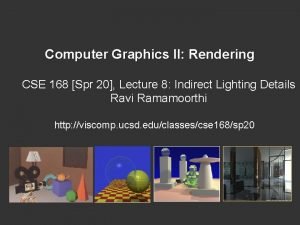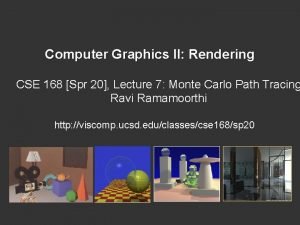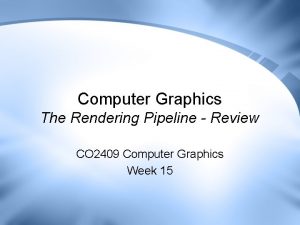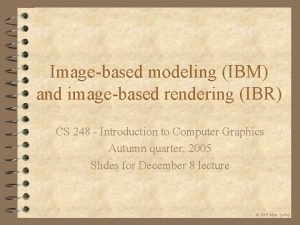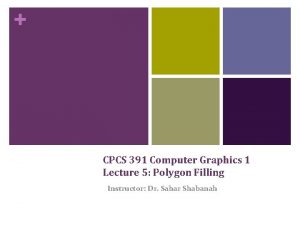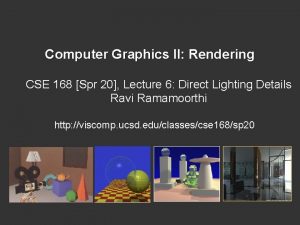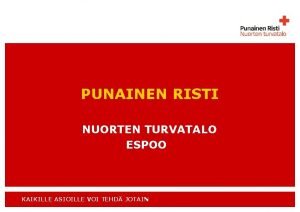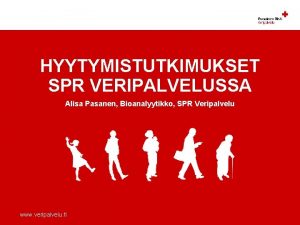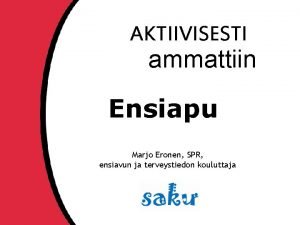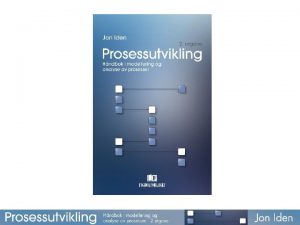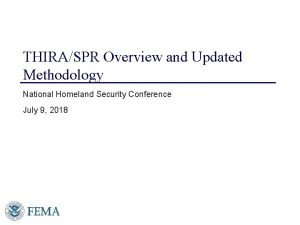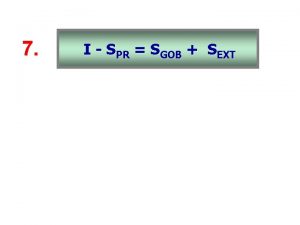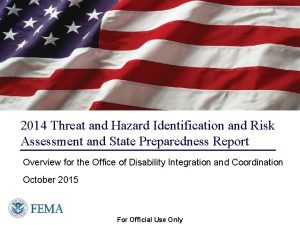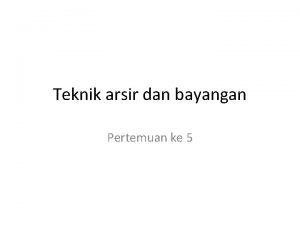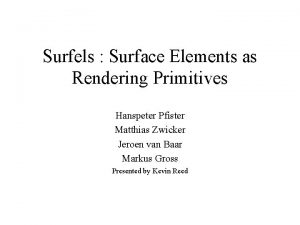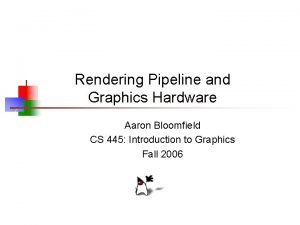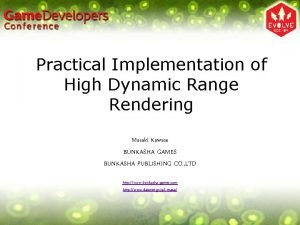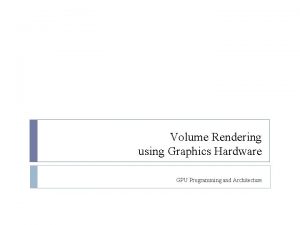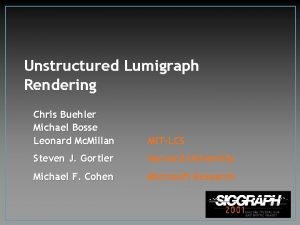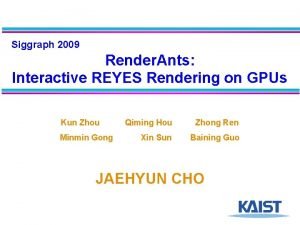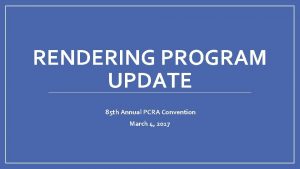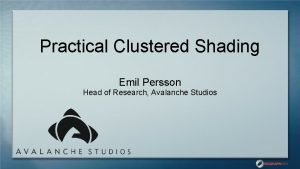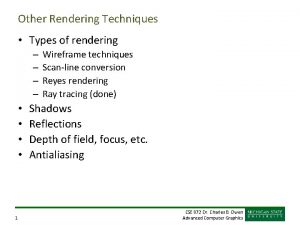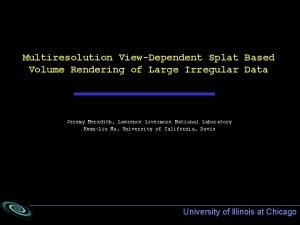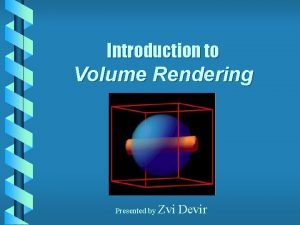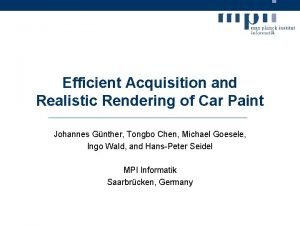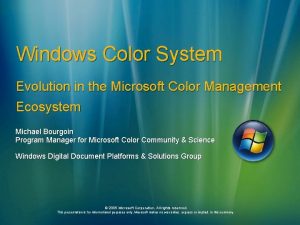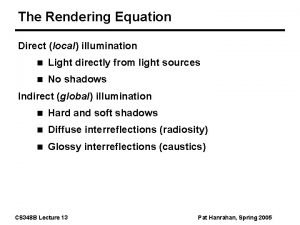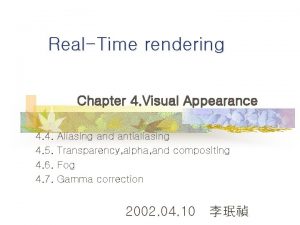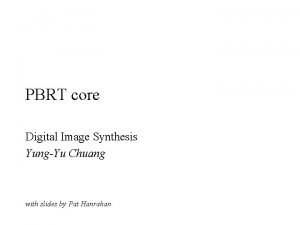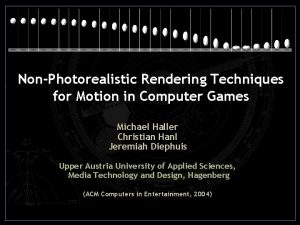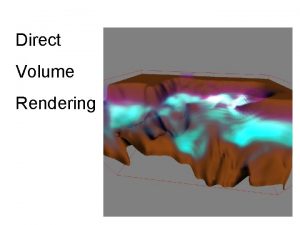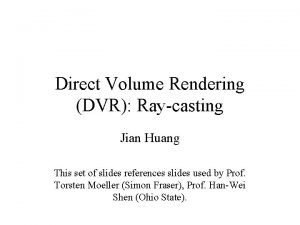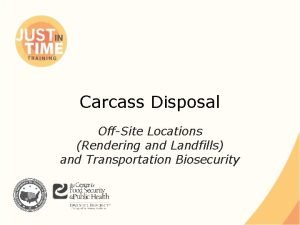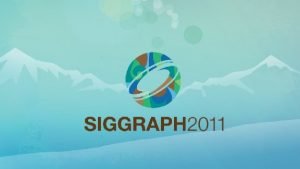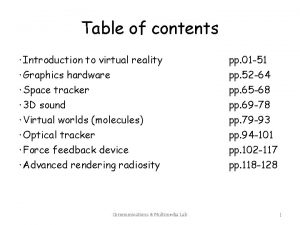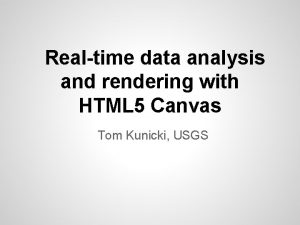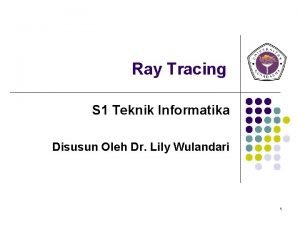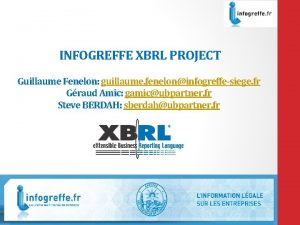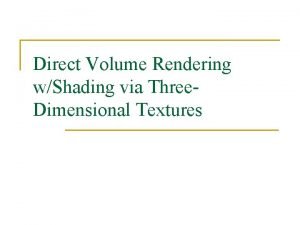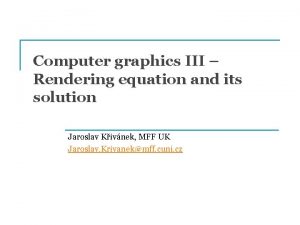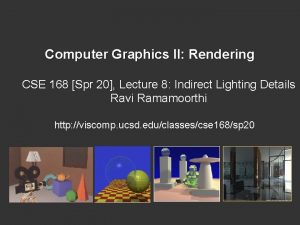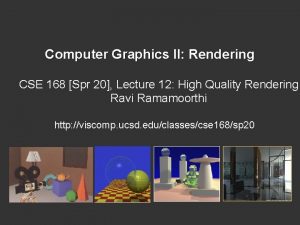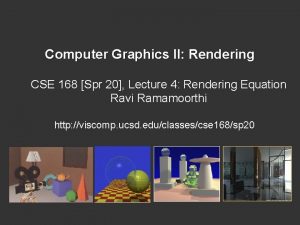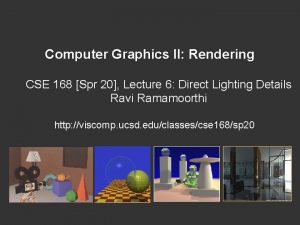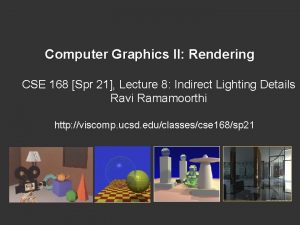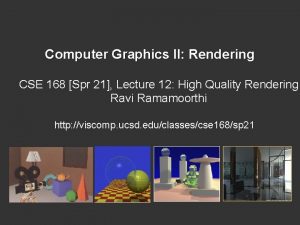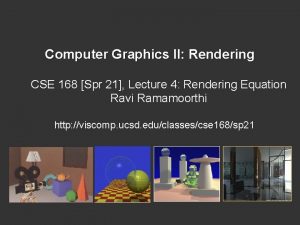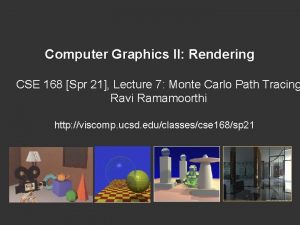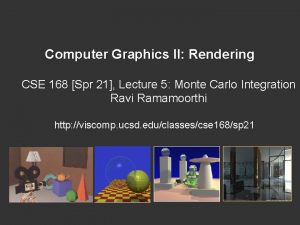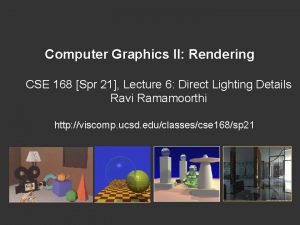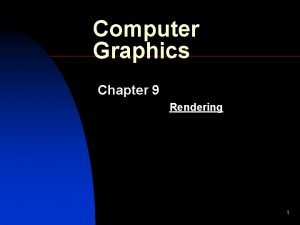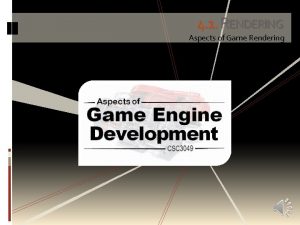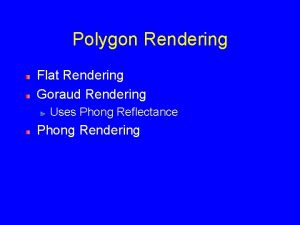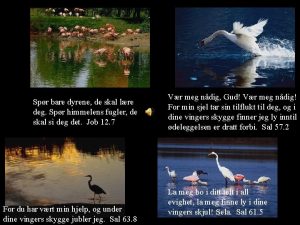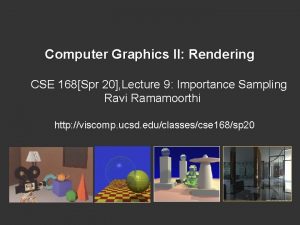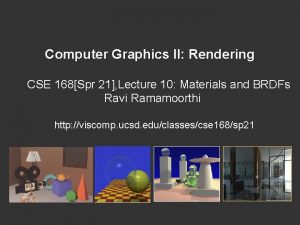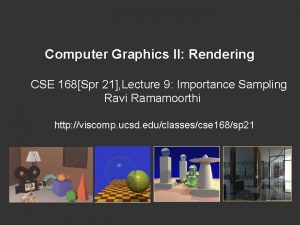Computer Graphics II Rendering CSE 168 Spr 21
![Computer Graphics II: Rendering CSE 168 [Spr 21], Lecture 3: Illumination and Reflection Ravi Computer Graphics II: Rendering CSE 168 [Spr 21], Lecture 3: Illumination and Reflection Ravi](https://slidetodoc.com/presentation_image_h2/7745fe14d89eab870d81f54902a53dcc/image-1.jpg)


![Diffuse Interreflection Diffuse interreflection, color bleeding [Cornell Box] Diffuse Interreflection Diffuse interreflection, color bleeding [Cornell Box]](https://slidetodoc.com/presentation_image_h2/7745fe14d89eab870d81f54902a53dcc/image-4.jpg)























![Building up the BRDF • Bi-Directional Reflectance Distribution Function [Nicodemus 77] • Function based Building up the BRDF • Bi-Directional Reflectance Distribution Function [Nicodemus 77] • Function based](https://slidetodoc.com/presentation_image_h2/7745fe14d89eab870d81f54902a53dcc/image-28.jpg)




















- Slides: 48
![Computer Graphics II Rendering CSE 168 Spr 21 Lecture 3 Illumination and Reflection Ravi Computer Graphics II: Rendering CSE 168 [Spr 21], Lecture 3: Illumination and Reflection Ravi](https://slidetodoc.com/presentation_image_h2/7745fe14d89eab870d81f54902a53dcc/image-1.jpg)
Computer Graphics II: Rendering CSE 168 [Spr 21], Lecture 3: Illumination and Reflection Ravi Ramamoorthi http: //viscomp. ucsd. edu/classes/cse 168/sp 21

To Do § Homework 1 (ray tracer) due early next week § Next assignment direct lighting (on UCSD online). Will cover that material next week

Illumination Models Local Illumination § Light directly from light sources to surface § No shadows (cast shadows are a global effect) Global Illumination: multiple bounces (indirect light) § Hard and soft shadows § Reflections/refractions (already seen in ray tracing) § Diffuse and glossy interreflections (radiosity, caustics) Some images courtesy Henrik Wann Jensen
![Diffuse Interreflection Diffuse interreflection color bleeding Cornell Box Diffuse Interreflection Diffuse interreflection, color bleeding [Cornell Box]](https://slidetodoc.com/presentation_image_h2/7745fe14d89eab870d81f54902a53dcc/image-4.jpg)
Diffuse Interreflection Diffuse interreflection, color bleeding [Cornell Box]

Radiosity

Caustics: Focusing through specular surface § Major research effort in 80 s, 90 s till today

Motivation: BRDFs, Radiometry § Basics of Illumination, Reflection § Formal radiometric analysis (not ad-hoc) § Reflection Equation (Local Illumination) § Discussion of BRDFs § Rendering Equation (Global Illumination) on Thu § Formal analysis important for correct implementation


Radiometry § Physical measurement of electromagnetic energy § Measure spatial (and angular) properties of light § Radiance, Irradiance § Reflection functions: Bi-Directional Reflectance Distribution Function or BRDF § Reflection Equation § Simple BRDF models





Radiance • Power per unit projected area perpendicular to the ray per unit solid angle in the direction of the ray • Symbol: L(x, ω) (W/m 2 sr) • Flux given by dΦ = L(x, ω) cos θ dω d. A

Radiance properties • Radiance constant as propagates along ray – Derived from conservation of flux – Fundamental in Light Transport.



Radiance properties • Sensor response proportional to radiance (constant of proportionality is throughput) – Far away surface: See more, but subtends smaller angle – Wall equally bright across viewing distances Consequences – Radiance associated with rays in a ray tracer – Other radiometric quants derived from radiance – This course primarily about computing radiance

Irradiance, Radiosity • Irradiance E is radiant power per unit area • Integrate incoming radiance over hemisphere – Projected solid angle (cos θ dω) – Uniform illumination: Irradiance = π [CW 24, 25] – Units: W/m 2 • Radiant Exitance (radiosity) – Power per unit area leaving surface (like irradiance)




Irradiance Environment Maps R Incident Radiance (Illumination Environment Map) N Irradiance Environment Map

Radiometry § Physical measurement of electromagnetic energy § Measure spatial (and angular) properties of light § Radiance, Irradiance § Reflection functions: Bi-Directional Reflectance Distribution Function or BRDF § Reflection Equation § Simple BRDF models



![Building up the BRDF BiDirectional Reflectance Distribution Function Nicodemus 77 Function based Building up the BRDF • Bi-Directional Reflectance Distribution Function [Nicodemus 77] • Function based](https://slidetodoc.com/presentation_image_h2/7745fe14d89eab870d81f54902a53dcc/image-28.jpg)
Building up the BRDF • Bi-Directional Reflectance Distribution Function [Nicodemus 77] • Function based on incident, view direction • Relates incoming light energy to outgoing • Unifying framework for many materials


BRDF • Reflected Radiance proportional Irradiance • Constant proportionality: BRDF • Ratio of outgoing light (radiance) to incoming light (irradiance) – Bidirectional Reflection Distribution Function – (4 Vars) units 1/sr



Isotropic vs Anisotropic § Isotropic: Most materials (you can rotate about normal without changing reflections) § Anisotropic: brushed metal etc. preferred tangential direction Isotropic Anisotropic


Reflection Equation Reflected Light (Output Image) Emission BRDF Incident Light (from light source) Cosine of Incident angle

Reflection Equation Sum over all light sources Reflected Light (Output Image) Emission BRDF Incident Light (from light source) Cosine of Incident angle

Reflection Equation Replace sum with integral Reflected Light (Output Image) Emission BRDF Incident Light (from light source) Cosine of Incident angle

Environment Maps § Light as a function of direction, from entire environment § Captured by photographing a chrome steel or mirror sphere § Accurate only for one point, but distant lighting same at other scene locations (typically use only one env. map) Blinn and Newell 1976, Miller and Hoffman, 1984 Later, Greene 86, Cabral et al. 87

Environment Maps § Environment maps widely used as lighting representation § Many modern methods deal with offline and real-time rendering with environment maps § Image-based complex lighting + complex BRDFs

Radiometry § Physical measurement of electromagnetic energy § Measure spatial (and angular) properties of light § Radiance, Irradiance § Reflection functions: Bi-Directional Reflectance Distribution Function or BRDF § Reflection Equation § Simple BRDF models

Brdf Viewer plots Diffuse Torrance-Sparrow Anisotropic bv written by Szymon Rusinkiewicz



Specular Term (Phong)



Torrance-Sparrow Fresnel term: allows for wavelength dependency How much of the macroscopic surface is visible to the light source Geometric Attenuation: reduces the output based on the amount of shadowing or masking that occurs. How much of the macroscopic surface is visible to the viewer Distribution: distribution function determines what percentage of microfacets are oriented to reflect in the viewer direction.

Other BRDF models § Empirical: Measure and build a 4 D table § Anisotropic models for hair, brushed steel § Cartoon shaders, funky BRDFs § Capturing spatial variation § Very active area of research
 168spr
168spr 168spr
168spr Rendering pipeline in computer graphics
Rendering pipeline in computer graphics Forma urbis
Forma urbis Graphics rendering
Graphics rendering Hand held computer
Hand held computer Introduction to computer graphics ppt
Introduction to computer graphics ppt Spr render
Spr render Spr words
Spr words Spr kontti palkkatuki
Spr kontti palkkatuki Nuorten turvatalo tampere
Nuorten turvatalo tampere Spr hyytymistekijä paketti
Spr hyytymistekijä paketti Eis standards
Eis standards Kylmä koho kompressio spr
Kylmä koho kompressio spr Nicoya spr
Nicoya spr Spr man
Spr man Thira/spr
Thira/spr Introduction of evaluation
Introduction of evaluation I spr
I spr Threat and hazard identification
Threat and hazard identification Teknik rendering bayangan
Teknik rendering bayangan Hanspeter pfister
Hanspeter pfister Camera translate
Camera translate High dynamic range rendering
High dynamic range rendering Volume rendering tutorial
Volume rendering tutorial Chris buehler
Chris buehler Reyes rendering
Reyes rendering Photorealistic rendering carlsbad
Photorealistic rendering carlsbad Clustered shading
Clustered shading Wireframe techniques
Wireframe techniques Splat rendering
Splat rendering Introduction to volume rendering
Introduction to volume rendering Car paint rendering
Car paint rendering Windowscolorsystem
Windowscolorsystem Light transport
Light transport Rendering realtime compositing
Rendering realtime compositing Kajiya rendering equation
Kajiya rendering equation Game rendering techniques
Game rendering techniques Indirect volume rendering
Indirect volume rendering Raycasting dda
Raycasting dda Rendering carcass
Rendering carcass Advances in real-time rendering in games
Advances in real-time rendering in games Kajiya rendering equation
Kajiya rendering equation Rendering realtime compositing
Rendering realtime compositing Teknik rendering grafik tiga dimensi dengan interaksi sinar
Teknik rendering grafik tiga dimensi dengan interaksi sinar Xbrl rendering tool
Xbrl rendering tool Rendering fur with three dimensional textures
Rendering fur with three dimensional textures Kajiya rendering equation
Kajiya rendering equation Maya rendering with aneka
Maya rendering with aneka
